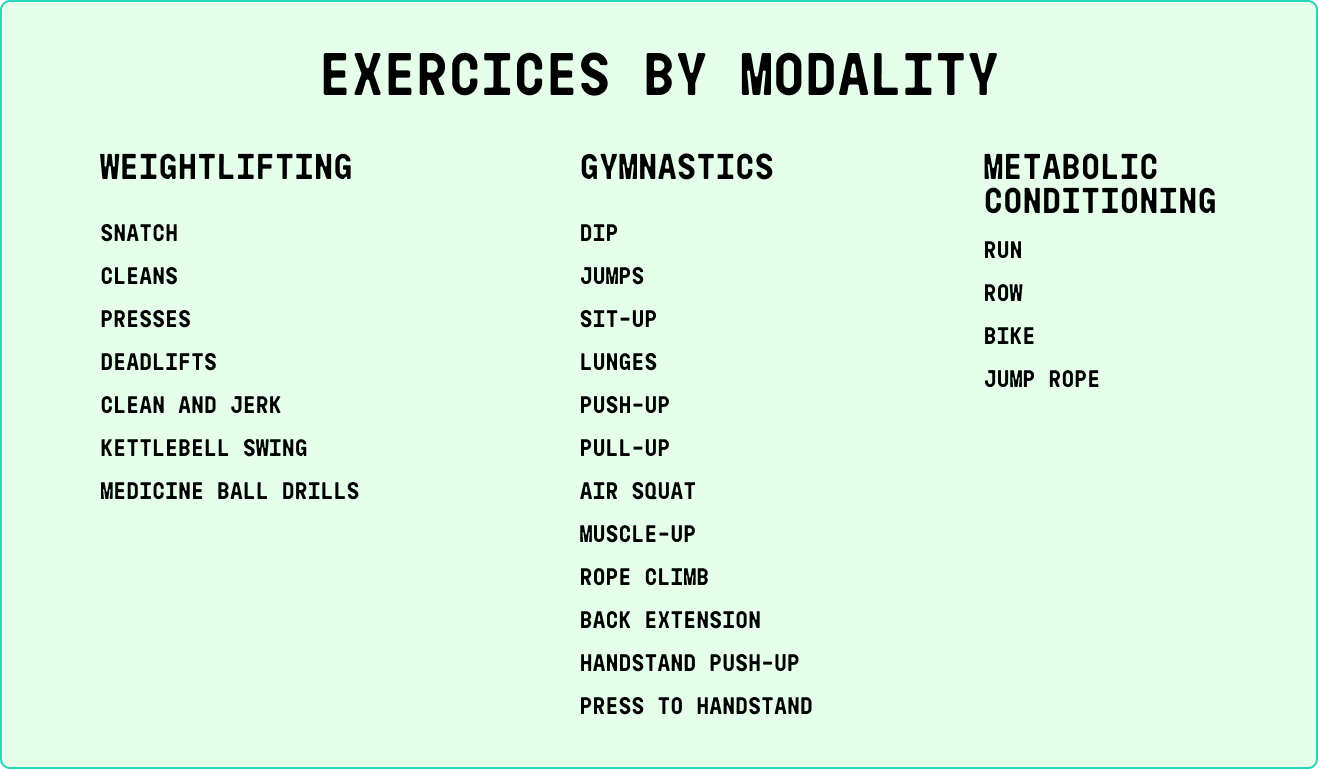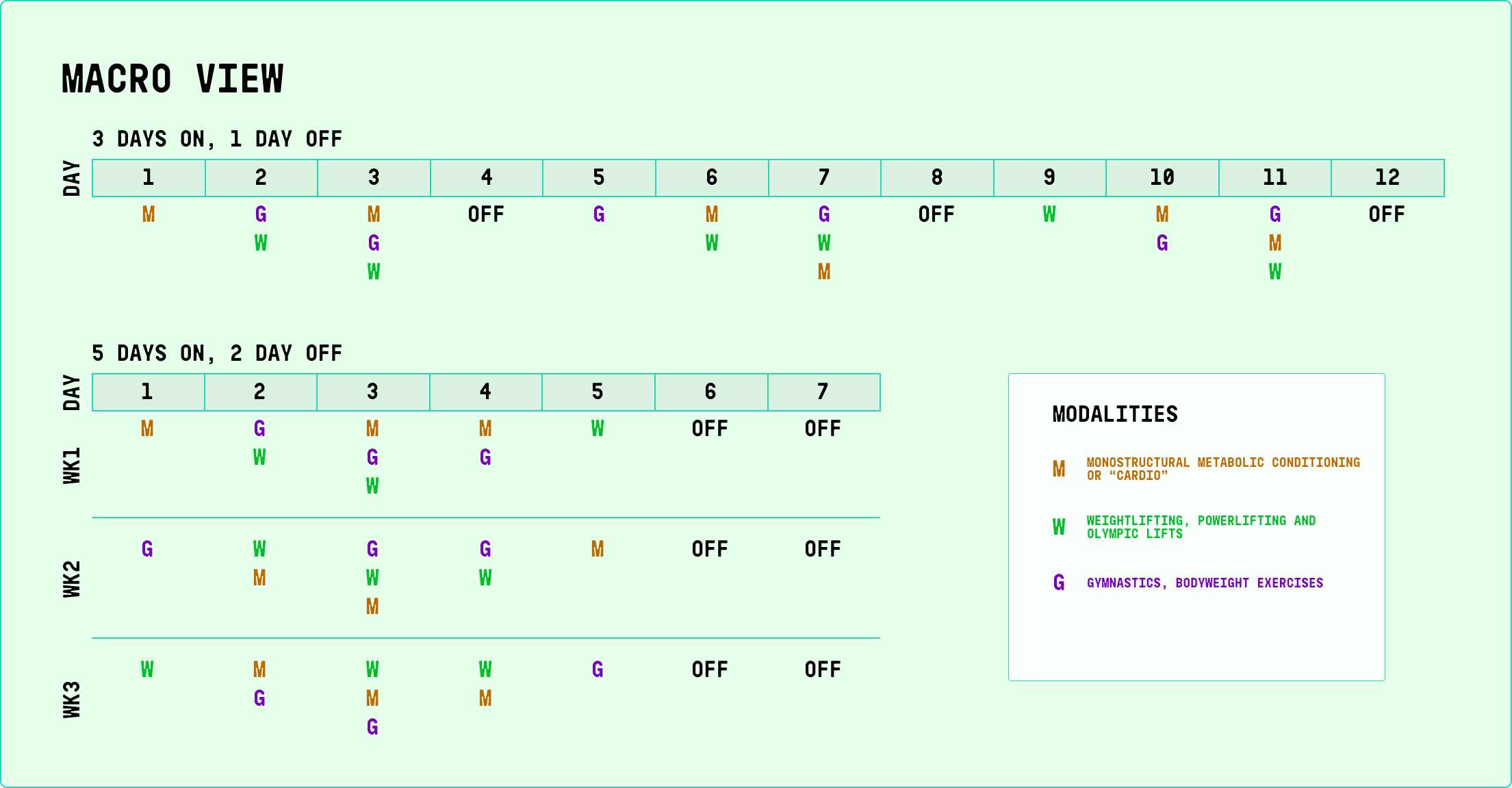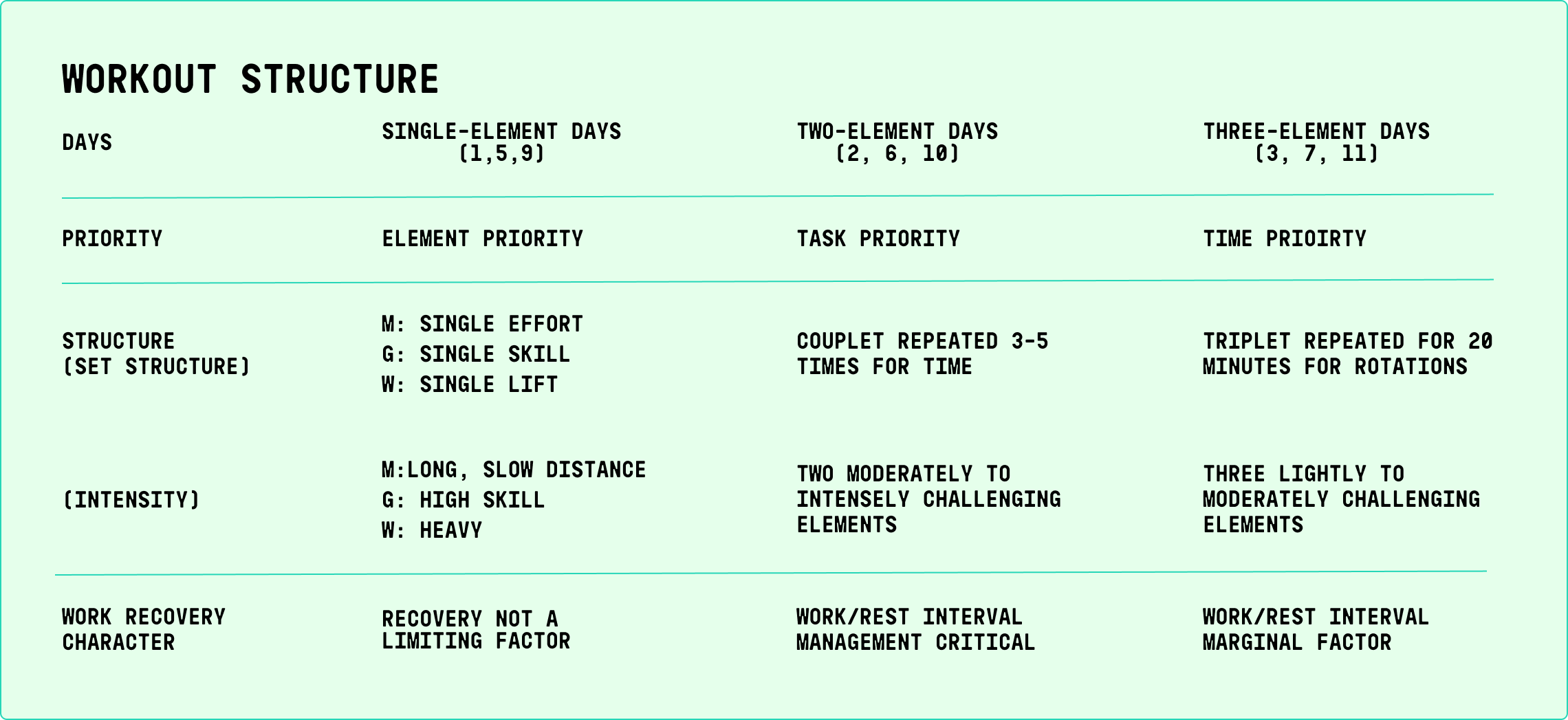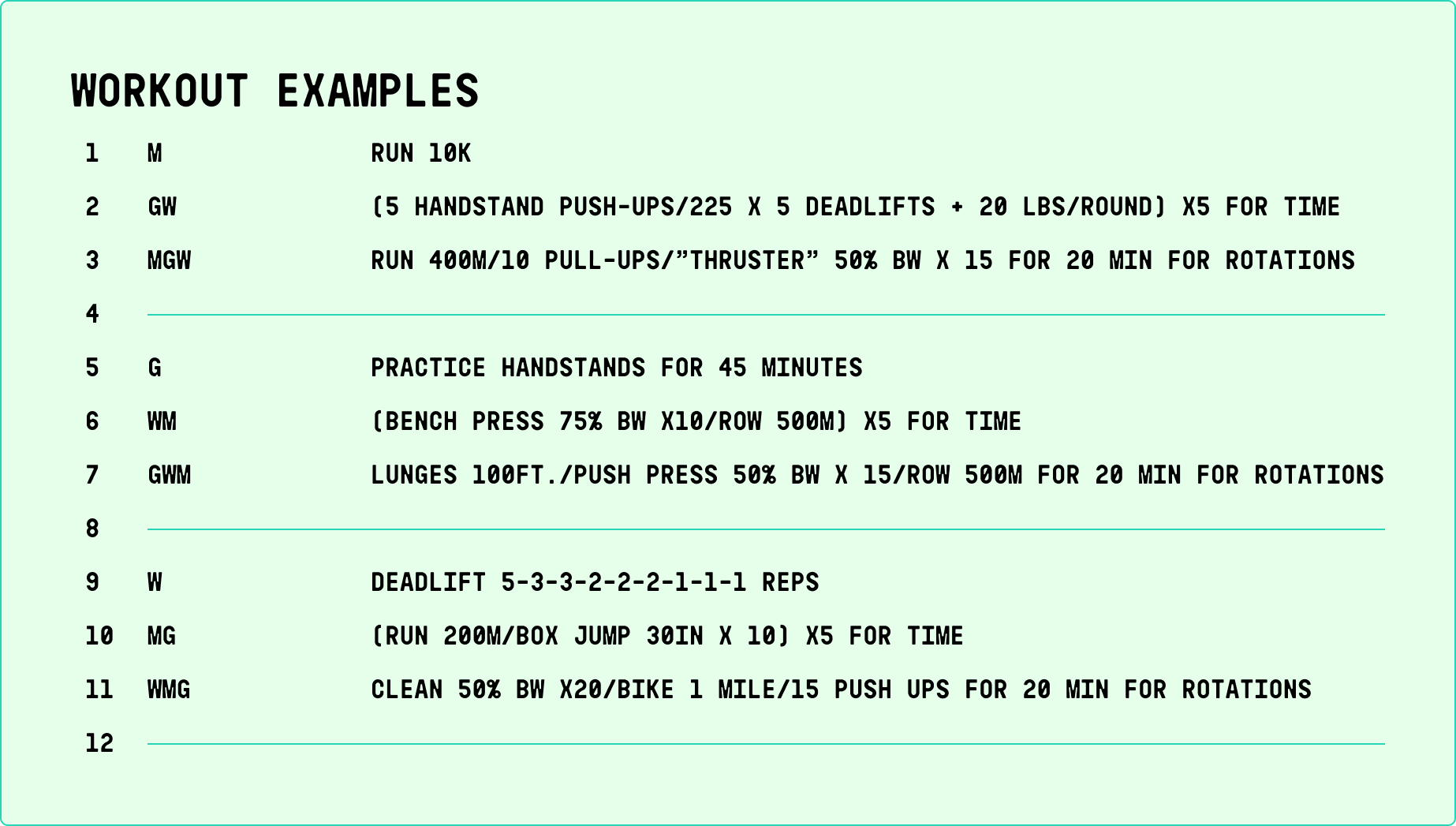A Theoretical Template for CrossFit’s Programming
Summary
In What is Fitness?, CrossFit defines fitness through three main models:
- The 10 general physical skills
- The hopper model
- The metabolic pathways
The article goes into detail about the theoretical aspect of fitness but doesn’t show you how the program could be implemented to build that fitness.
This template gives you an example of how to implement CrossFit while holding to the core principles and developing maximum fitness in the three models above.
The concluding paragraph sums it up well:
The template encourages new skill development, generates unique stressors, crosses modes, incorporates quality movements, and hits all three metabolic pathways. It does this within a framework of sets and reps and a cast of exercises that CrossFit has repeatedly tested and proven effective. We contend that this template does a reasonable job of formally expressing many CrossFit objectives and values.
The main structure in the template is a three-day-on, one-day-off cadence. This allows for maximum intensity on the days you hit the gym while still giving plenty of recovery time. Greg has found if you push past 3-4 days you lose intensity (and thus results).
Though it does mention you can do a 5-day-on, 2-day-off pattern if that fits your schedule better. I personally do 3 days on, 1 day off, 2 days on, 1 day off each week.
Within the three day cycles, there are three modalities that can be assigned to each day:
- Monostructural (cardio)
- Gymnastics
- Weightlifting

For each 3 day cycle, the first day is a single element day, the second day is a two element day, and the third day is a three element day.

This allows for each day to have a different focus in the mini cycle. Single element days are typically long, slow when cardio, high-skill when gymnastic, and heavy when weightlifting.
Two element days are moderate to high intensity where each element is high intensity. Managing the work-rest interval is critical for these pieces. These effots are typically task priority.
Three element days build intensity through the repeated efforts of the individual elements. Each element itself shouldn’t be too strenuous, but the combination builds. These efforts are typically time priority and 20 minutes long.

The article concludes with the example cycle below:

Highlights
- [page 1]: It is our aim in this issue to offer a model or template for our workout programming in the hope of elaborating on the CrossFit concept and potentially stimulating productive thought on the subject of exercise prescription generally and workout construction specifically.
- [page 1]: At first glance the template seems to be offering a routine or regimen.
- [page 1]: This may seem at odds with our contention that workouts need considerable variance or unpredictability, if not randomness, to best mimic the often unforeseeable challenges that combat, sport, and survival demand and reward. We’ve often said, “What your regimen needs is to not become routine.”
- [page 1]: But the model we offer allows for wide variance of mode, exercise, metabolic pathway, rest, intensity, sets, and reps. In fact, it is mathematically likely that each three-day cycle is a singularly unique stimulus never to be repeated in a lifetime of CrossFit workouts.
- [page 1]: The template is engineered to allow for a wide and constantly varied stimulus, randomized within some parameters, but still true to the aims and purposes of CrossFit as described in the “What is Fitness? ” issue.
- [page 1]: That is our mission – to ideally blend structure and flexibility.
- [page 1]: It is not our intention to suggest that your workouts should or that our workouts do fit neatly and cleanly within the template, for that is absolutely not the case.
- [page 1]: In the broadest view we see a three-day-on, one-dayoff pattern. We’ve found that this allows for a relatively higher volume of high-intensity work than the many others that we’ve experimented with. With this format the athlete can work at or near the highest intensities possible for three straight days, but by the forth day both neuromuscular function and anatomy are hammered to the point where continued work becomes noticeably less effective and impossible without reducing intensity.
- [page 2]: it does not sync with the five-day-on, two-day-off pattern that seems to govern most of the world’s work habits.
- [page 2]: For these people we have devised a five-days-on, two-days-off regimen that has worked very well.
- [page 2]: it can readily be seen that the workouts are composed of three distinct modalities: metabolic conditioning (“M”), gymnastics (“G”), and weightlifting (“W”).
- [page 2]: The workout of the day was originally a five-on, twooff pattern and it worked perfectly. But the threeon, one-off pattern was devised to increase both the intensity and recovery of the workouts and the feedback “cardio,” the purpose of The workout of the day was originally a five-on, twooff pattern and it worked perfectly. But the threeon, one-off pattern was devised to increase both the intensity and recovery of the workouts and the feedback we’ve received and our observations suggest that it was successful in this regard. which is primarily to improve sets, and reps. and cardiorespir
- [page 2]: The gymnastics capacity If life is easier with the fiveon, two-off pattern, don’t modality comprises body hesitate to employ it. The weight exercises/elements difference in potential between the two may not warrant or calisthenics and its primary purpose is to improve restructuring your entire life to accommodate the more body control by improving neurological components
- [page 3]: like coordination, balance, agility, and accuracy, and to improve functional upper body capacity and trunk strength.
- [page 3]: The weightlifting modality comprises the most important weight training basics, Olympic lifts and powerlifting, where the aim is primarily to increase strength, power, and hip/leg capacity.
- [page 3]: The elements, or exercises, chosen for each modality were selected for their functionality, neuroendocrine response, and overall capacity to dramatically and broadly impact the human body.
- [page 3]: When the workout includes a single exercise (days 1, 5, and 9) the focus is on a single exercise or effort.
- [page 3]: When the element is the single “M” (day 1) the workout is a single effort and is typically a long, slow, distance effort. When the modality is a single “G” (day 5) the workout is practice of a single skill and typically this skill is sufficiently complex to require great practice and may not be yet suitable for inclusion in a timed workout because performance is not yet adequate for efficient inclusion. When the modality is the single “W” (day 9) the workout is a single lift and typically performed at high weight and low rep.
- [page 3]: On the single-element days (1, 5, and 9), recovery is not a limiting factor. For the “G” and “W” days rest is long and deliberate and the focus is kept clearly on improvement of the element and not on total metabolic effect.
- [page 4]: These elements are made intense by pace, load, reps or some combination. Ideally the first round is hard but possible, whereas the second and subsequent rounds will require pacing, rest, and breaking the task up into manageable efforts.
- [page 4]: We say these days are “task priority” because the task is set and the time varies. The workout is very often scored by the time required to complete five rounds. The two elements themselves are designed to be moderate to high intensity and workrest interval management is critical.
- [page 4]: If the second round can be completed without trouble, the elements are too easy.
- [page 4]: For the three-element days (3, 7, and 11), the structure is typically a triplet of exercises, this time repeated for 20 minutes and performed and scored by number of rotations completed in twenty minutes.
- [page 5]: “time priority” because the athlete is kept moving for a specified time and the goal is to complete as many cycles as possible.
- [page 5]: Ideally the elements chosen are not significant outside of the blistering pace required to maximize rotations completed within the time (typically 20 minutes) allotted.
- [page 5]: This is in stark contrast to the twoelement days, where the elements are of a much higher intensity. This workout is tough, extremely tough, but managing work-rest intervals is a marginal factor.
- [page 5]: Generally speaking, as the number of elements increases from one to two to three, the workout’s effect is due less to the individual element selected and more to the effect of repeated efforts.
- [page 5]: Our experience in the gym and the feedback from our athletes following the WOD have demonstrated that the mix of one, two, and three element workouts are crushing in their impact and unrivaled in bodily response.
- [page 5]: Typically our most effective workouts, like art, are remarkable in composition, symmetry, balance, theme, and character. There is a “choreography” of exertion that draws from a working knowledge of physiological response, a well-developed sense of the limits of human performance, the use of effective elements, experimentation, and even luck.
- [page 5]: The template encourages new skill development, generates unique stressors, crosses modes, incorporates quality movements, and hits all three metabolic pathways.
- [page 5]: It does this within a framework of sets and reps and a cast of exercises that CrossFit has repeatedly tested and proven effective. We contend that this template does a reasonable job of formally expressing many CrossFit objectives and values.